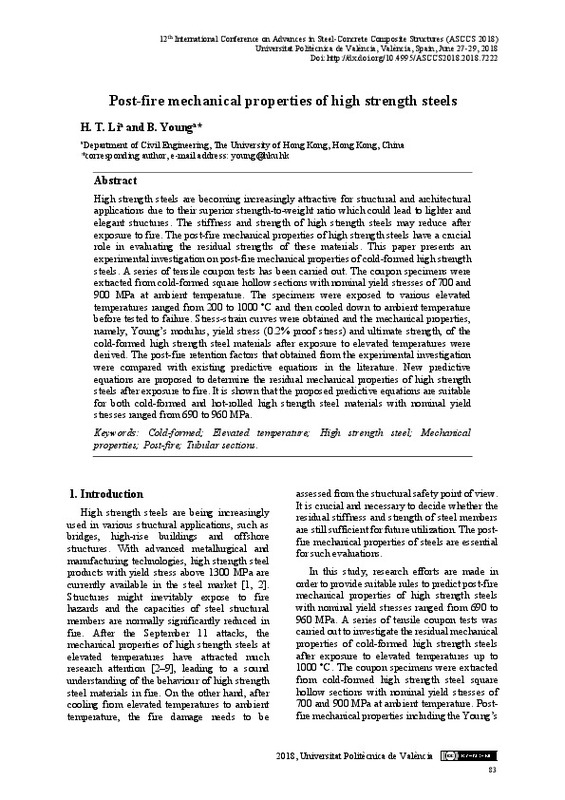JavaScript is disabled for your browser. Some features of this site may not work without it.
Buscar en RiuNet
Listar
Mi cuenta
Estadísticas
Ayuda RiuNet
Admin. UPV
Post-fire mechanical properties of high strength steels
Mostrar el registro sencillo del ítem
Ficheros en el ítem
| dc.contributor.author | Li, Hai-Ting
|
es_ES |
| dc.contributor.author | Young, Ben
|
es_ES |
| dc.date.accessioned | 2018-10-01T07:39:34Z | |
| dc.date.available | 2018-10-01T07:39:34Z | |
| dc.date.issued | 2018-06-05 | |
| dc.identifier.isbn | 9788490486016 | |
| dc.identifier.uri | http://hdl.handle.net/10251/108741 | |
| dc.description.abstract | [EN] High strength steels are becoming increasingly attractive for structural and architectural applications due to their superior strength-to-weight ratio which could lead to lighter and elegant structures. The stiffness and strength of high strength steels may reduce after exposure to fire. The post-fire mechanical properties of high strength steels have a crucial role in evaluating the residual strengths of these materials. This paper presents an experimental investigation on post-fire mechanical properties of cold-formed high strength steels. A series of tensile coupon tests has been carried out. The coupon specimens were extracted from cold-formed square hollow sections with nominal yield stresses of 700 and 900 MPa at ambient temperature. The specimens were exposed to various elevated temperatures ranged from 200 to 1000 °C and then cooled down to ambient temperature before tested to failure. Stress-strain curves were obtained and the mechanical properties, namely, Young’s modulus, yield stress (0.2% proof stress) and ultimate strength, of the cold-formed high strength steel materials after exposure to elevated temperatures were derived. The post-fire retention factors that obtained from the experimental investigation were compared with existing predictive equations in the literature. New predictive equations are proposed to determine the residual mechanical properties of high strength steels after exposure to fire. It is shown that the proposed predictive equations are suitable for both cold-formed and hot-rolled high strength steel materials with nominal yield stresses ranged from 690 to 960 MPa. | es_ES |
| dc.format.extent | 8 | es_ES |
| dc.language | Inglés | es_ES |
| dc.publisher | Editorial Universitat Politècnica de València | es_ES |
| dc.relation.ispartof | Proceedings of the 12th International Conference on Advances in Steel-Concrete Composite Structures. ASCCS 2018 | es_ES |
| dc.rights | Reconocimiento - No comercial - Sin obra derivada (by-nc-nd) | es_ES |
| dc.subject | Cold-formed | es_ES |
| dc.subject | Elevated temperature | es_ES |
| dc.subject | High strength steel | es_ES |
| dc.subject | Mechanical properties | es_ES |
| dc.subject | Post-fire | es_ES |
| dc.subject | Tubular sections | es_ES |
| dc.title | Post-fire mechanical properties of high strength steels | es_ES |
| dc.type | Capítulo de libro | es_ES |
| dc.type | Comunicación en congreso | es_ES |
| dc.identifier.doi | 10.4995/ASCCS2018.2018.7222 | |
| dc.rights.accessRights | Abierto | es_ES |
| dc.description.bibliographicCitation | Li, H.; Young, B. (2018). Post-fire mechanical properties of high strength steels. En Proceedings of the 12th International Conference on Advances in Steel-Concrete Composite Structures. ASCCS 2018. Editorial Universitat Politècnica de València. 83-90. https://doi.org/10.4995/ASCCS2018.2018.7222 | es_ES |
| dc.description.accrualMethod | OCS | es_ES |
| dc.relation.conferencename | 12th international conference on ‘Advances in Steel-Concrete Composite Structures’ - ASCCS 2018 | es_ES |
| dc.relation.conferencedate | Junio 27-29,2018 | es_ES |
| dc.relation.conferenceplace | Valencia, Spain | es_ES |
| dc.relation.publisherversion | http://ocs.editorial.upv.es/index.php/ASCCS/ASCCS2018/paper/view/7222 | es_ES |
| dc.description.upvformatpinicio | 83 | es_ES |
| dc.description.upvformatpfin | 90 | es_ES |
| dc.type.version | info:eu-repo/semantics/publishedVersion | es_ES |
| dc.relation.pasarela | OCS\7222 | es_ES |








